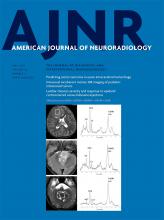Index by author
Vadapalli, R.
- FELLOWS' JOURNAL CLUBPediatricsYou have accessFocal Cortical Dysplasia and Refractory Epilepsy: Role of Multimodality Imaging and Outcome of SurgeryS. Jayalakshmi, S.K. Nanda, S. Vooturi, R. Vadapalli, P. Sudhakar, S. Madigubba and M. PanigrahiAmerican Journal of Neuroradiology May 2019, 40 (5) 892-898; DOI: https://doi.org/10.3174/ajnr.A6041
The authors performed a retrospective analysis of data from 188 consecutive patients with focal cortical dysplasia and refractory epilepsy with at least 2 years of postsurgery follow-up. Predictors of seizure freedom and the sensitivity of neuroimaging modalities were analyzed. MR imaging showed clear-cut FCD in 136 (72.3%) patients. Interictal FDG-PET showed focal hypo-/hypermetabolism in 144 (76.6%); in 110 patients in whom ictal SPECT was performed, focal hyperperfusion was noted in 77 (70.3%). Focal resection was the most common surgery performed in 112 (59.6%) patients. Histopathology revealed type I FCD in 102 (54.3%) patients. At last follow-up, 124 (66.0%) were seizure-free. Complete resection of FCD and type II FCD were predictors of seizure freedom. Localization of FCD on either MR imaging or PET or ictal SPECT had the highest sensitivity for seizure freedom at 97.5%. They conclude that during presurgical multimodality evaluation, localization of the extent of the epileptogenic zone in at least 2 imaging modalities helps achieve seizure freedom in about two-thirds of patients with refractory epilepsy due to FCD. FDG-PET is the most sensitive imaging modality for seizure freedom, especially in patients with type I FCD.
Valand, H.A.
- You have accessChimeric Antigen Receptor T-Cell Therapy: What the Neuroradiologist Needs to KnowH.A. Valand, F. Huda and R.K. TuAmerican Journal of Neuroradiology May 2019, 40 (5) 766-768; DOI: https://doi.org/10.3174/ajnr.A6042
Vargas, S.A.
- PediatricsYou have accessNeuroimaging Findings in Moebius SequenceD.A. Herrera, N.O. Ruge, M.M. Florez, S.A. Vargas, M. Ochoa-Escudero and M. CastilloAmerican Journal of Neuroradiology May 2019, 40 (5) 862-865; DOI: https://doi.org/10.3174/ajnr.A6028
Venneti, S.
- FELLOWS' JOURNAL CLUBPediatricsYou have accessPediatric Atypical Teratoid/Rhabdoid Tumors of the Brain: Identification of Metabolic Subgroups Using In Vivo 1H-MR SpectroscopyB. Tamrazi, S. Venneti, A. Margol, D. Hawes, S.Y. Cen, M. Nelson, A. Judkins, J. Biegel and S. BlümlAmerican Journal of Neuroradiology May 2019, 40 (5) 872-877; DOI: https://doi.org/10.3174/ajnr.A6024
Twenty patients with confirmed atypical teratoid/rhabdoid tumors who underwent MR spectroscopy were included in this study. In vivo metabolite levels of atypical teratoid/rhabdoid tumors were compared with molecular subtypes assessed by achaete-scute homolog 1 expression. In vivo creatine concentrations were higher in tumors that demonstrated achaete-scute homolog 1 expression compared with those without achaete-scute homolog 1 expression. Additionally, levels of myo-inositol were significantly different, whereas lipids approached significance in these 2 cohorts. Higher brain-specific creatine kinase levels were observed in the cohort with achaete-scute homolog 1 expression.
Verny, C.
- Adult BrainYou have accessGJA1 Variants Cause Spastic Paraplegia Associated with Cerebral HypomyelinationL. Saint-Val, T. Courtin, P. Charles, C. Verny, M. Catala, R. Schiffmann, O. Boespflug-Tanguy and F. MochelAmerican Journal of Neuroradiology May 2019, 40 (5) 788-791; DOI: https://doi.org/10.3174/ajnr.A6036
Vooturi, S.
- FELLOWS' JOURNAL CLUBPediatricsYou have accessFocal Cortical Dysplasia and Refractory Epilepsy: Role of Multimodality Imaging and Outcome of SurgeryS. Jayalakshmi, S.K. Nanda, S. Vooturi, R. Vadapalli, P. Sudhakar, S. Madigubba and M. PanigrahiAmerican Journal of Neuroradiology May 2019, 40 (5) 892-898; DOI: https://doi.org/10.3174/ajnr.A6041
The authors performed a retrospective analysis of data from 188 consecutive patients with focal cortical dysplasia and refractory epilepsy with at least 2 years of postsurgery follow-up. Predictors of seizure freedom and the sensitivity of neuroimaging modalities were analyzed. MR imaging showed clear-cut FCD in 136 (72.3%) patients. Interictal FDG-PET showed focal hypo-/hypermetabolism in 144 (76.6%); in 110 patients in whom ictal SPECT was performed, focal hyperperfusion was noted in 77 (70.3%). Focal resection was the most common surgery performed in 112 (59.6%) patients. Histopathology revealed type I FCD in 102 (54.3%) patients. At last follow-up, 124 (66.0%) were seizure-free. Complete resection of FCD and type II FCD were predictors of seizure freedom. Localization of FCD on either MR imaging or PET or ictal SPECT had the highest sensitivity for seizure freedom at 97.5%. They conclude that during presurgical multimodality evaluation, localization of the extent of the epileptogenic zone in at least 2 imaging modalities helps achieve seizure freedom in about two-thirds of patients with refractory epilepsy due to FCD. FDG-PET is the most sensitive imaging modality for seizure freedom, especially in patients with type I FCD.
Vossough, A.
- LetterYou have accessUse of Balanced Steady-State Free Precession Sequences in Evaluation of Drop MetastasesA. Vossough and E.R. MelhemAmerican Journal of Neuroradiology May 2019, 40 (5) E20; DOI: https://doi.org/10.3174/ajnr.A5964








